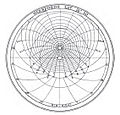The Franklin's Tale
| Advanced search |
- About 3 results found and you can help!
 Dorigen and Aurelius, from Mrs. Haweis's, Chaucer for Children (1877). Note the black rocks in the sea and the setting of the garden, a typical site for courtly love. |
While the idea of the magical disappearance of rocks has a variety of potential sources, there is no direct source for the rest of the story. The rocks possibly come from the legends of Merlin performing a similar feat, or might stem from an actual event. In 2000 a paper was published showing that the magician in the Franklin's Tale attempts to make the rocks disappear in December. In fact, on December 19, 1340 (commonly viewed as the year of Chaucer's birth) the sun and moon were both at their closest distance to earth; an event which will not recur till 3089 and which causes massive high tides. The theme of the story, though, is less obscure—that of the "rash promise", in which an oath is made that the person does not envisage having to fulfill. The earliest examples of the "rash promise" motif are found in the Sanskrit stories of the Vetala as well as Bojardo's Orlando Innamorto and Don Juan Manuel's Tales of Count Lucanor.
- See also: Wikipedia, Wikisource
- Related: Add a related term
| The Franklin's Tale with interlinear translation The Franklin's Tale with interlinear translation www.courses.fas.harvard.edu/~chaucer/teachslf/frkt-par.htm - Web |
| Modern Translation of the Franklin's Tale and Othe... Modern Translation of the Franklin's Tale and Other Resources at eChaucer www.umm.maine.edu/faculty/necastro/chaucer/ct/frant/ - Web |
| The Franklin's Tale The Franklin's Tale www.eleusinianm.co.uk/yellowCalbourne/bof4franklins.html - Web |
Gallery for «The Franklin's Tale»
Average relevance



